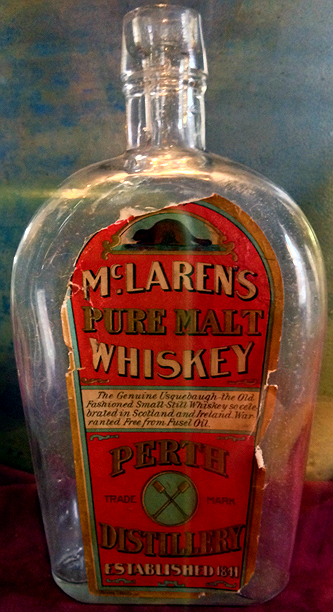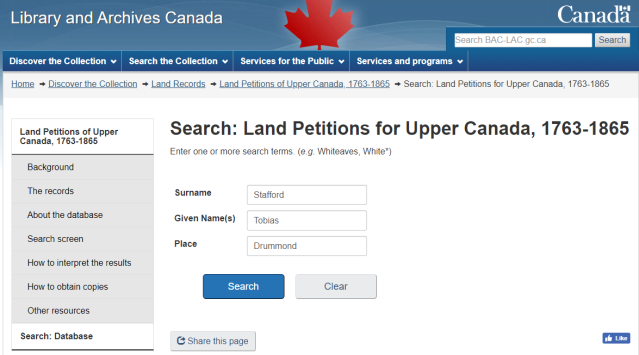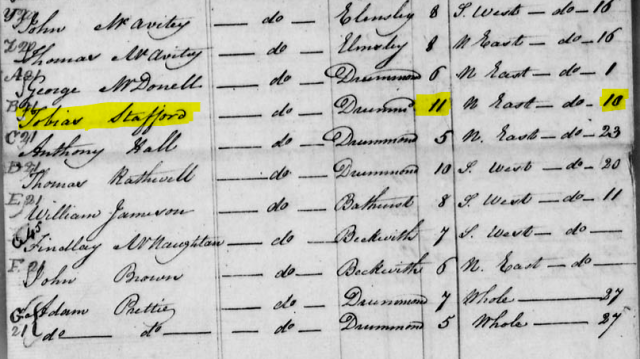The story of John McLaren, Perth, Ontario’s whiskey baron, and eligible bachelor millionaire, is one of the town’s most intriguing tales. Inventor of the ‘Mickey’, McLaren amassed a fortune during his lifetime, and when he died, unmarried and childless, there was a great deal of interest in who would inherit his money.
Read about the McLaren fortune, the scandalous court case, and the people who tried to claim a share of his millions. The story, “Perth’s Millionaire Bachelor” is one of a collection of short stories in the new book, “Lanark County Comfort”:
Who would inherit his millions?
Minnie, his special girl?
His half-sister Barbara?
His half-brother Hugh?
His half-sister Eliza?
His business manager, Frank?
His nephew, Jack?
His niece, Janet?
John McLaren – Inventor of the Mickey
First to manufacture ‘the Mickey’ – liquor in a 12 ounce bottle, Perth native John McLaren made his fortune distilling alcohol.
A Mickey is actually one of a series of uniquely Canadian alcohol measurements. “Two four” (a case of 24 beers), “twenty-sixer” (a 750 ml bottle of liquor) and “forty-pounder” (a 1.14 liter bottle of liquor) are all virtually unknown outside of Canada.
The very first ‘Mickey‘ was John McLaren’s “Old Perth Malt Whiskey”, a bottle could be had for .80 cents, and was hailed as being “equal to the best ever brewed in Scotland”. Most whiskies in those days were aged very briefly, usually four days or less, and McLaren aged his for a full month before it was distributed to the local bars and liquor stores around Lanark County.
“McLaren’s Whiskey – Aged for a full month!”
“.90 cents for a mickey, – .80 cents if you bring your bottle back for a refill…”
Robert McLaren, an enterprising young man from Scotland, founded the McLaren Distillery in Perth, in 1841, on a section of land known today as Stewart Park. He died before his son John, came of age, and the business was placed in a trust with Robert’s wife, John’s step-mother. John took over the distillery around 1866 when he was in his mid-thirties.

Some say it was the combination of the clear waters of the Tay River and the secrets learned from the Scots that led John to become the local ‘Whiskey King’ or ‘Baron of Booze’.

photo: Henry Kehoe sitting in front of Spalding and Stewart Distillery in Perth.


“McLaren’s whiskey, produced with water from the Tay River in Perth, cures flat feet and the common cold!”
A favourite among whiskey judges, Old Perth Malt Whiskey enjoyed a unique reputation and even some doctors of the time regarded it as “non-injurious”. It became a household staple, said to cure everything from flat feet to the common cold. The popularity of McLaren’s whiskey grew in leaps and bounds, and in its heyday was sold from coast to coast, all across Canada.

photo: from Perth Remembered
John laboured day and night, expanding his operations, and became the town’s wealthiest businessman. Some say he was secretive, reserved, and was not one to discuss his personal or business matters.

Photo above: J.A. McLaren Distillery – located behind the town hall in present-day Stewart Park.

photo: ‘Perth Remembered’
John McLaren, Perth Whiskey King
Found Dead !!!!!

Eligible Perth Bachelor John McLaren
dies without a will!
He never married, had no children, and for the most part lived a quiet life and kept to himself. When John McLaren passed away at the turn of the century, many in the town of Perth began to speculate – who would be the heir or heirs to his fortune?

By 1902 the town of Perth was “never more absorbed in one topic of conversation” as they were during the trial held in the local courtroom to settle the case of John McLaren’s Will.
Frank Walker, long-time employee swore that John McLaren had confided in him about his childhood and they shared a special relationship.

Walker told the court that John promised he would be taken care of from the proceeds of John’s estate”
“If I die tonight, you are provided for.”

John A. Stewart, McLaren’s nephew, well-known Perth lawyer, and respected member of parliament, claimed that he drafted a will for Mr. McLaren in 1897, witnessed his signature on the document, and that his uncle had left everything to him.

photo: John A. Stewart, McLaren’s nephew
Lizzie McIntyre said
she had John McLaren’s will
stuffed down the front of her dress !!!

“Why in Hell should I have a will?”
Frank Buffam swore that John McLaren
didn’t even have a will:

Lizzie McIntyre accused George Rogers of stealing McLaren’s will from his house at midnight:

Many people in Perth thought John McLaren left his millions to Minnie Hamilton. The lovely Minnie was known as his ‘favourite’. She was McLaren’s live-in ‘housekeeper’ in their hideaway home outside of Lanark:
“Everyone knew that Minnie was his special girl!”

………………………………………..
Many local businesses carried spirits manufactured
by McLaren’s Distillery in 1903:
Smiths Falls: 9 hotels and 1 store
Carleton Place: 8 hotels
Perth: 7 hotels and 2 stores
Franktown: 2 hotels
Ferguson’s Falls: 1 hotel
Innisville: 1 hotel
Maberly: 1 hotel

Early Hotels of Perth
– from an article “The Perth Courier” – 1964
“The year 1896 was a good period for the hotel industry in Perth. Five recorded hotels flourished within the town boasting a grand total of 165 rooms, and five bars.
According to 19th century observers, Perth had a high caliber of service, and had an excellent reputation as a fine hotel town. One such observer was the old Perth Expositor which noted how strangers “always judge a town by its hotels” and then carried the impression of hospitality and service to the far reaches of the land.
The hotel business of 1898 was a vast improvement over the rude taverns and inns of early days. Several of the hotels survived the turn of the century and can be readily seen in today’s busy commercial trade. The only hotel still bearing the same name and remaining in the same location is the Revere House at Wilson and Foster.
The hotels of Perth began just prior to the Boer War, and were five: Barrie’s Hotel, Hicks House, Allen House, Revere House and Queen’s Hotel. They were all located in the business section of down town Perth and catered to a through trade from road, stage and traveling salesmen. Since 1900 the road trade has shifted west to Highway 7 where an assortment of motels enjoy a lucrative business from an almost entirely auto trade.
In 1896 the oldest hotel was Barrie’s operated by Thomas Barrie. It had thirty rooms and a well stocked bar. A resort of the surrounding farming community, the hotel enjoyed a heavy seasonal business. Mr. Barrie was hailed as a “jolly good natured fellow” with a “pleasant greeting” for all.
The Hicks House, now the Perth Hotel, was hailed as the “leading commercial hotel” in eastern Ontario, sporting a bar, billiard room, free bus rides and a variety of fare on the table. The proprietor was John Wilson, noted for his catering and disciplining of the “hotel attaches”.
The Queen’s occupied thirty rooms, a bar, a billiard room and stables across from what is now Girdwoods Store on Foster Street. Owned by Frank A. Lambert, father of Edward Lambert, present day proprietor of the Imperial Hotel on Wilson, the Queen’s closed its quarters in 1918 after purchasing Barrie’s from James P. Hogan who succeeded Mr. Barrie as operator. Queen’s and Barrie’s are thus the modern day Imperial Hotel operated by Ed Lambert who took over from his father in 1934.
In 1896 Revere House was a 25 room establishment run by W.J. Flett who is described as one of the best hotel men in the valley. He enjoyed a popular local trace.
Largest hotel in Perth, now closed to business, was a fifty room spread called the Allan House, situated to the west of the town hall in a block now occupied by Chaplin and Code and the Coin Wash. Andrew Robinson the proprietor, was famous for his “uniform courtesy and kindness” and the free bus rides to the train and stages. Mr. Robinson purchased the Allan House from I.C. Grant after ten years as an employee of the Hicks House.
Needless to say, the hotels of Perth had close connections with Crystal Sprine Brewery and McLaren’s Distillery, two enterprises which made Perth famous from Nova Scotia to British Columbia.”
(article published in “The Perth Courier” 1964)

……………………
Did one of these Business Owners in Perth inherit McLaren’s money?
Someone in Perth got McLaren’s millions!
*images of John McLaren, his whiskey, and ads for the Perth Distillery, and transcripts of the McLaren will case – from – “The Perth Courier”
photo – Henry Kehoe in front of Spalding and Stewart Distillery – “The Perth Courier”
photo – McLaren’s amber glass whisky bottle from ‘Collectable Treasures’
photos – malt whiskey bottle, whiskey jug, old distillery photos – Perth Remembered
“So, who inherited John McLaren’s vast fortune?”
Did his ‘girl’, Minnie Hamilton inherit McLaren’s millions?
Was it his nephew, George Rogers?
Did lawyer John Stewart get the money?
Was it his half-sister, Lizzie McIntyre?
Did he leave the money to business manager,Frank Walker?
Who inherited the money from the Whiskey King?
To discover more about the curious case of John McLaren’s will, and the trial that had the whole town of Perth talking, read the story “Perth’s Millionaire Bachelor”, from the book “Lanark County Comfort”.
At The Book Nook, 60 Gore Street E., Perth, Ontario. o order, or to reserve a copy: 613-267-2350.
Available :lanarkcountybooks@gmail.com or at The Book Nook, Spark Books https://www.sparkperth.ca/ in Perth, and Mill Street Books https://millstreetbooks.com/, in Almonte.

Arlene Stafford-Wilson






































